Howdy! Good to see y’all back on the trail. Today were headed out of Montana and back to big beautiful Wyoming. In my first blog, I mentioned Sheridan turned this cowgirl’s head and stole my heart. So, we’re gonna visit the area again and then head on down the trail. Let’s get those wagons movin’ we’re burnin’ daylight and we’ve got a ways to go!
The Battle of the Little Big Horn and the subsequent surrender of the Sioux and Northern Cheyenne brought to an end the American Indian conflicts, for all intents and purposes. This opened the door to lands on the eastern slope of the Big Horn mountains to ranchers, cowboys, and homesteaders. John Loucks founded the town of Sheridan in 1882, to serve as a hub for these inhabitants.
When John Loucks arrived, visiting his friend James Works in 1882, he found George Mandel’s post office in a little cabin where the Rock Creek stage line crossed Big Goose Creek. An old cabin built in 1878 by a trapper known as Dutch Henry was nearby, along with a horse barn for the stage-line teams. These buildings became the nucleus for the emerging town.
Works convinced Loucks to stay, and Loucks purchased Mandel’s cabin and claim for $50. Loucks then traveled south to find a justice of the peace so he could be sworn in as postmaster. On his return, Loucks rested as what today is Courthouse Hill. Enthralled by the abundant grass and grazing herds of buffalo and deer, he returned to the cabin and sketched out the town of his dreams on a piece of brown wrapping paper. He named the town for the commander he served under during the Civil War, General Phil Sheridan.
In May 1882, Loucks had an engineer, Jack Dow, from the neighboring town of Big Horn City survey the 40-acre town. Streets were named after several men who had already taken up claims in the area and helped with the survey: Kenneth Burkitt, James Works, George Brundage, Alexander Gould, L.H. Brooks, and W. Scott.
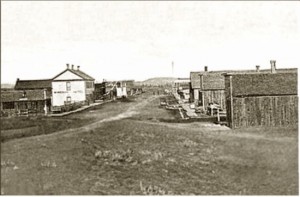 Another of Sheridan’s earliest townsmen, and a man who appears in a few of my stories so a personal favorite, is Henry Held. Held was heading for Yellowstone country when he pulled up his wagon to stay overnight in the brand new town of Sheridan. When Loucks found out the new arrival was a blacksmith, he made Dutch Henry’s cabin available and Held set up shop there. Held filed claim on adjacent land and purchased lots in Sheridan where he built his new blacksmith shop on the northwest corner of Main and Works Streets.
Another of Sheridan’s earliest townsmen, and a man who appears in a few of my stories so a personal favorite, is Henry Held. Held was heading for Yellowstone country when he pulled up his wagon to stay overnight in the brand new town of Sheridan. When Loucks found out the new arrival was a blacksmith, he made Dutch Henry’s cabin available and Held set up shop there. Held filed claim on adjacent land and purchased lots in Sheridan where he built his new blacksmith shop on the northwest corner of Main and Works Streets.
Henry Held’s blacksmith shop was the first structure built on the new Main Street in 1882. Held also built the town’s first irrigation ditch, developed one of the earliest subdivisions, and helped build the first electric light plant. He later donated land for the city cemetery.
Of course every Old West town had to have a saloon, and Cow Boy Saloon was Sheridan’s first. It served the areas inhabitants until it became a drugstore after a few years.
John Conrad built his general merchandise store across from the Cow Boy Saloon. Conrad’s store carried everything from knitting needles to threshing machines. Sheridan’s third oldest building still stands at the northeast corner of Main and Loucks Street and has housed the Hospital Pharmacy since the 1980s.
The Grand Central was Sheridan’s first hotel. All of Sheridan’s townspeople, 17 women and 65 men, attended the opening ball on July 3, 1883. The nine-room hotel was replaced by the Keenan Building in 1914.
Other Sheridan firsts include: The first seventeen children to attend school in John Loucks’s cabin, and the first frame school built in 1884. Built at a cost of $1000.00, Loucks contributed the extra $200 for the bell and belfry. Henry Coffeen, who also built a complex of stores known as Coffeen Hall, organized the first fair in Sheridan south of town near Little Goose Creek. Livestock and agriculture shows were a big part of the fair, but horse racing was the most popular event.
Almost half of Sheridan’s 1,000 residents gathered at the depot to welcome the first passenger train at 10:00 a.m. on November 18, 1892. Burlington and Missouri River Railroad executives announced their intent to build a line through Sheridan in 1888, expanding the towns population and connecting Sheridan to the outside world.
Sheridan always had the inside track on its selection as the railroad’s route through northern Wyoming. Several of the Burlington and Missouri Railroad officials from Omaha owned property in the Sheridan area and realized the value of expansion there. With local investors Edward Whitney, Horace Alger, and C.H. Grinnell, they formed the Sheridan Land Company, and built the Sheridan Inn in 1893, right across from the B&M Depot.
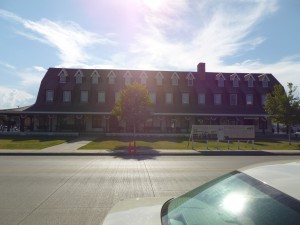 The Inn featured the first running-water bathtubs and electric lights in town, and the first telephone line was connected to a downtown drugstore. Inn guests have included such notables as Ernest Hemingway, Will Rogers, Bob Hope, Robert Taylor, and several presidents.
The Inn featured the first running-water bathtubs and electric lights in town, and the first telephone line was connected to a downtown drugstore. Inn guests have included such notables as Ernest Hemingway, Will Rogers, Bob Hope, Robert Taylor, and several presidents.
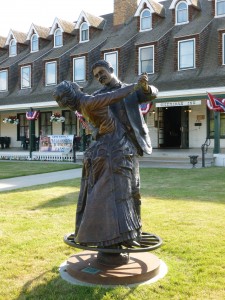 Among its guests was also Buffalo Bill Cody. In 1894, Cody became a Sheridan Land Company partner. Cody auditioned local cowboys for his famous Wild West show from the comfort of the inn’s large porch. Some of the cowboys’ wives were featured in one of the Wild West’s acts. The ladies rode sidesaddle and, with their partners, performed a square dance on horseback. The Inn is still there in Sheridan. You can order a cold one at the same bar where Wild Bill ordered a round for the house, and one of his business partners George Beck originated the popular drink called the Wyoming Slug (a concoction of champagne and whiskey). And a personal note their steak is fabulous and just a warning order one desert to share.
Among its guests was also Buffalo Bill Cody. In 1894, Cody became a Sheridan Land Company partner. Cody auditioned local cowboys for his famous Wild West show from the comfort of the inn’s large porch. Some of the cowboys’ wives were featured in one of the Wild West’s acts. The ladies rode sidesaddle and, with their partners, performed a square dance on horseback. The Inn is still there in Sheridan. You can order a cold one at the same bar where Wild Bill ordered a round for the house, and one of his business partners George Beck originated the popular drink called the Wyoming Slug (a concoction of champagne and whiskey). And a personal note their steak is fabulous and just a warning order one desert to share.
Speaking of cowboys, and this is Wyoming so we have to talk about cowboys, Sheridan had its share. You can read about John Kendrick in a previous post, so let’s visit some others.
Some of the largest ranches in Wyoming are in the Sheridan area. Ranchers like W.H. “Doc” Spear, Bill Glasgow, Andy Martinson, Lew Burgess, Nelson Darlington, Guy Wood and Bill Leavitt established large landholdings in the area. One of the largest and earliest ranches in the area was started west of Sheridan by two brothers Matt and Al Patrick, who also had the stage line contract from Rock Creek in southern Wyoming to Custer Station on the Yellowstone River. The PK Ranch is still one of the largest in the area, and portions of it have been set aside as a nature conservancy.
On the heels of ranching came a uniquely western phenomenon, the dude ranch came to 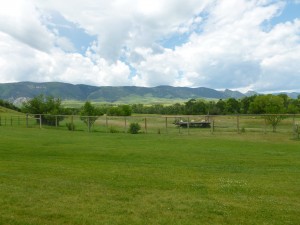 Sheridan. Ranchers discovered that not only friends, but complete strangers were willing to pay for the privilege of riding horses and even helping out with the chores. In 1890, Daniel T. Hilman operated the first dude ranch in Sheridan County near Big Horn when he accepted the first two of a long line of visitors.
Sheridan. Ranchers discovered that not only friends, but complete strangers were willing to pay for the privilege of riding horses and even helping out with the chores. In 1890, Daniel T. Hilman operated the first dude ranch in Sheridan County near Big Horn when he accepted the first two of a long line of visitors.
Dude ranches flourished in Sheridan County in the early half of the 19th century. The Dude Rancher’s Association in the West was formed in 1926 to set standards for the industry. The Burlington Railroad helped out by printing special maps of dude ranches in Wyoming and Montana.
The Eaton brothers, Howard, Willis Larimer, and Alden Eaton, launched the nation’s first dude ranch in 1880s at their ranch in North Dakota. The brothers moved their ranch to Wolf, just north of Sheridan, in 1903 making it the second dude ranch in Sheridan County. The Eatons ranch remains one of the better-known dude operations.
When people think of Wyoming, dude ranches can come to mind. Most visitors to Sheridan, myself included, are surprised to learn the sport of polo is alive and well int the American West. Afterall, polo isn’t a typical western sport.
However, the sport of kings found a western home when three Britons introduced the sport in the 1890s. The Moncreiffe brothers bought a ranch just outside Big Horn and named it the Quarter Circle A. Malcolm Moncreiffe and Oliver Henry Wallop and Malcolm’s brother William, partnered to provide 22,550 remounts for the British cavalry engaged in the Boer War. The Moncreiffes became known for the quality of their stock including polo ponies. William Moncreiffe’s registered brand is the second oldest in Wyoming.
It was Malcolm Moncreiffe who was the driving force behind polo in Sheridan County. In 1901, Malcolm developed the first polo field on what would become Polo Ranch southwest of Big Horn, where polo was played until 1984. Since then, the game has been played at the Big Horn Equestrian/Events Center where world-class players and horses appear every summer.
In addition to Big Horn’s Polo Ranch, the game was played at several sites around Sheridan. Cowboys played polo around Saberton Avenue before the hospital was built there and at Sheridan’s original fairgrounds. In 1900, the first match played for a cup took place behind the old Western Hotel near Works and Brooks Streets.
The local Big Horn team, called the Magpies, wore distinctive black and white vests. They traveled to Colorado to compete in matches with teams, including several fielded by the U.S. Army.
William Moncreiffe married in 1908 and remained on the ranch until 1923 when it was sold 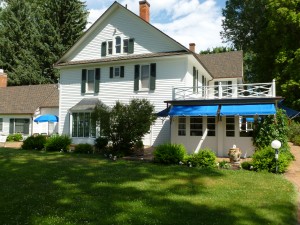 to an Illinois businessman, Bradford Brinton. Brinton used the ranch as a vacation home. Brinton collected many pieces of western art and expanded the ranch. The Bradford Brinton Memorial Museum is opened for visitors and showcases the historic home and vast art collection.
to an Illinois businessman, Bradford Brinton. Brinton used the ranch as a vacation home. Brinton collected many pieces of western art and expanded the ranch. The Bradford Brinton Memorial Museum is opened for visitors and showcases the historic home and vast art collection.
Oliver Henry Wallop married Marguerite who was the sister of Amy Moncreiffe (Malcolm Moncreiffe’s wife). Wallop became a United States citizen in 1904 and was elected to the Wyoming legislature in 1908. However, the death of his older brother forced him to assume the earlship and membership in the British House of Lords in 1925. His grandson Malcolm Wallop served for many years as one of Wyoming’s U.S. Senators.
A more familiar site in Western sports is rodeo, and since its beginning Sheridan’s has 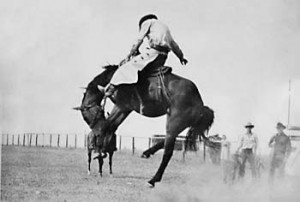 always been one of the best in the West. The Sheridan-WYO rodeo, established in 1931, features all the finest rodeo events. The organizers of the Sheridan-WYO had three goals: keep Sheridan residents home, provide a mid-summer event in Sheridan, and advertise Sheridan to tourists. From its start, the rodeo attracted some of the biggest names in the sport of its day.
always been one of the best in the West. The Sheridan-WYO rodeo, established in 1931, features all the finest rodeo events. The organizers of the Sheridan-WYO had three goals: keep Sheridan residents home, provide a mid-summer event in Sheridan, and advertise Sheridan to tourists. From its start, the rodeo attracted some of the biggest names in the sport of its day.
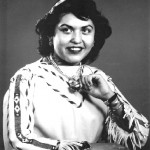 From the beginning, the Sheridan-WYO included a strong American Indian presence. After facing cancellation during World War II, the rodeo came back strong. And in 1952, Lucy Yellowmule, a shy Crow girl, was selected rodeo queen. Aided by reporter Howard Sinclair, Lucy turned her reign into an opportunity to improve American Indian and white relations. She made many public appearances to dispel myths and share American Indian culture. Gradually, new appreciation was gained on both sides. American Indian leaders organized an event called All-American Indian Days, celebrating all tribal cultures and featured a pageant to select Miss Indian America.
From the beginning, the Sheridan-WYO included a strong American Indian presence. After facing cancellation during World War II, the rodeo came back strong. And in 1952, Lucy Yellowmule, a shy Crow girl, was selected rodeo queen. Aided by reporter Howard Sinclair, Lucy turned her reign into an opportunity to improve American Indian and white relations. She made many public appearances to dispel myths and share American Indian culture. Gradually, new appreciation was gained on both sides. American Indian leaders organized an event called All-American Indian Days, celebrating all tribal cultures and featured a pageant to select Miss Indian America.
Like all Western towns Sheridan has faced fire, flood, boom times and bust times, but year after year the people of Sheridan have struggled, straggled, rebuilt, built more, persevered and preserved their history. It’s no wonder Sheridan is continually named one of if not the number one Western town in America. But folks we have a little more traveling to do before nightfall. I know, I know it rips my heart out to leave Sheridan, too, but these next stops will be worth the trip. We’re heading into the Big Horn National Forest.
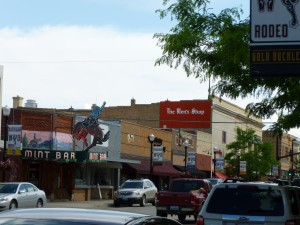 Before we head out let’s make one last stop at the Mint Bar, established in 1907, still in business on North Main Street. It was at the Mint, Theodore Roosevelt noted that cowboys “when drunk on the villainous whiskey” would “cut mad antics such as riding their horses into the saloons.” And indeed, the custom continues today. The Mint Bar continued to operate through prohibition, although quietly. Upon the repeal of prohibition it officially reopened. Sheridan even had its own brewery, the Sheridan Brewery, maker of Sheridan Export and Sheridan Pale, in business from 1885-1954. The Mint makes an appearance in one of my stories, and yes a cowboy rides his horse into the saloon.
Before we head out let’s make one last stop at the Mint Bar, established in 1907, still in business on North Main Street. It was at the Mint, Theodore Roosevelt noted that cowboys “when drunk on the villainous whiskey” would “cut mad antics such as riding their horses into the saloons.” And indeed, the custom continues today. The Mint Bar continued to operate through prohibition, although quietly. Upon the repeal of prohibition it officially reopened. Sheridan even had its own brewery, the Sheridan Brewery, maker of Sheridan Export and Sheridan Pale, in business from 1885-1954. The Mint makes an appearance in one of my stories, and yes a cowboy rides his horse into the saloon.
The Big Horn National Forest is eighty miles long and thirty miles wide. The Forest covers 1,115,073 acres, and extend from the Great Basin area of Wyoming northward to Montana. Elevations range from 5,500 feet to 13,175 feet (Cloud Peak).
Hold onto your mules folks we’re headin’ up the Dayton-Kane Highway! God bless your hearts! Make sure your supplies are tied down tight and iffin ya don’t like heights I’d hunker in the back of the wagon.
The Dayton-Kane was named for two small communities. Dayton is still there, but Kane was destroyed when the Bureau of Reclamation condemned the land and bought the community in 1965 when the Yellowtail Dam neared completion and the Bighorn Lake would flood Kane.
All that being said let’s head up the road and by up I mean waaay-up. First stop, Sand 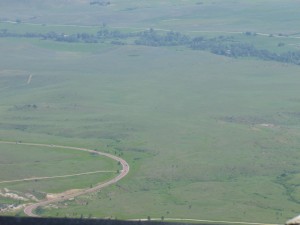 Turn. I’ll just stand back and let you take all the pictures you’d like. It’s an amazing site looking over the road you just traveled, all the twists and turns. Many visitors hang glide from Sand Turn and best of luck to them, I’m getting back in the wagon.
Turn. I’ll just stand back and let you take all the pictures you’d like. It’s an amazing site looking over the road you just traveled, all the twists and turns. Many visitors hang glide from Sand Turn and best of luck to them, I’m getting back in the wagon.
As we travel take time to check out all the gorgeous wildflowers at their peak in the Big Horns in late June and early July. It can take a good bit of time to get down the mountains when you stop every few feet for a photo opportunity (this is from personal experience, but I’d do it all again).
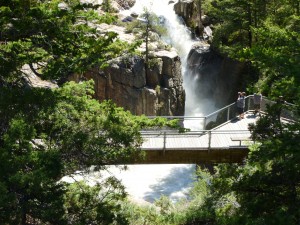 Next stop are the Shell Falls. These are spectacular and make sure you walk the paths to get the falls from all angles and find other falls cascading down the mountains.
Next stop are the Shell Falls. These are spectacular and make sure you walk the paths to get the falls from all angles and find other falls cascading down the mountains.
Another interesting spot is the old Beef Trail. I don’t mind taking pictures, but Cookie would demand a huge raise if this trail boss took the herd up that narrow path and this trail boss would demand a huge sedative.
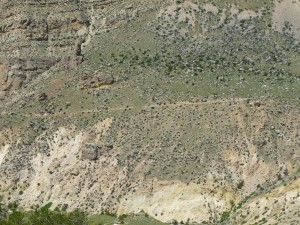 We’ll just ease on down into the basin leaving the majesty of these mountains. Hope y’all enjoyed just this brief glimpse of what Sheridan and the surrounding area offers. But please folks if ya only choose one place to visit from all these posts make Sheridan and the Big Horns it!
We’ll just ease on down into the basin leaving the majesty of these mountains. Hope y’all enjoyed just this brief glimpse of what Sheridan and the surrounding area offers. But please folks if ya only choose one place to visit from all these posts make Sheridan and the Big Horns it!
Now if ya’ll will excuse Cookie and me we have to go shed a few tears around the campfire. We always get a might choked up when we visit this piece of God’s country. Below are some links to places to visit that should keep ya busy for a time and give ol Cookie some time to compose hisself for the next leg of our journey!
KING’S SADDLERY AND DON KING MUSEUM
*All colored photographs are property of Kirsten Lynn
*Black and white photographs from “Tales and Trails Wyoming”
Sources:
Sheridan County Museum (Information from placards around Museum)
Blair, Pat, Prater, Dana and the Sheridan County Museum. Images of America: Sheridan. Arcadia Publishing, 2008.
Wagons West Sheridan @ Kirsten Lynn 2012



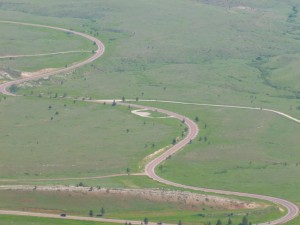
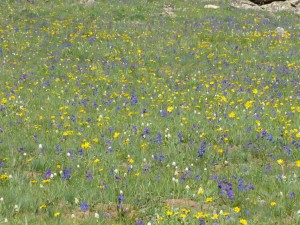
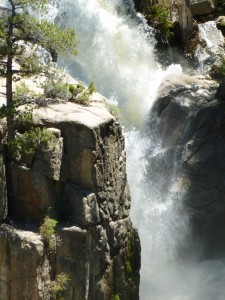


Kirsten, I love what you do here. It makes all us who are far from the West envious.
Thank you so much, Sara, for your kind words. If I can bring a bit of the West to everyone that’s what it’s all about on my blog and in my writing. Thanks for stopping by, hope you’ll come back!
Sara, I just checked out your website! Your books sound wonderful, I’ll definitely have to head over to Amazon and pick up a copy!
Sheridan is a place I’ve never been to. Someday I’ll get home and go sightseeing.
Alison, I’d only been through it a couple times before dad suggested I use it in a story, then I visited. You really need to go, it’s gorgeous, and just a great town. Thanks for reining in at the campfire! :o)